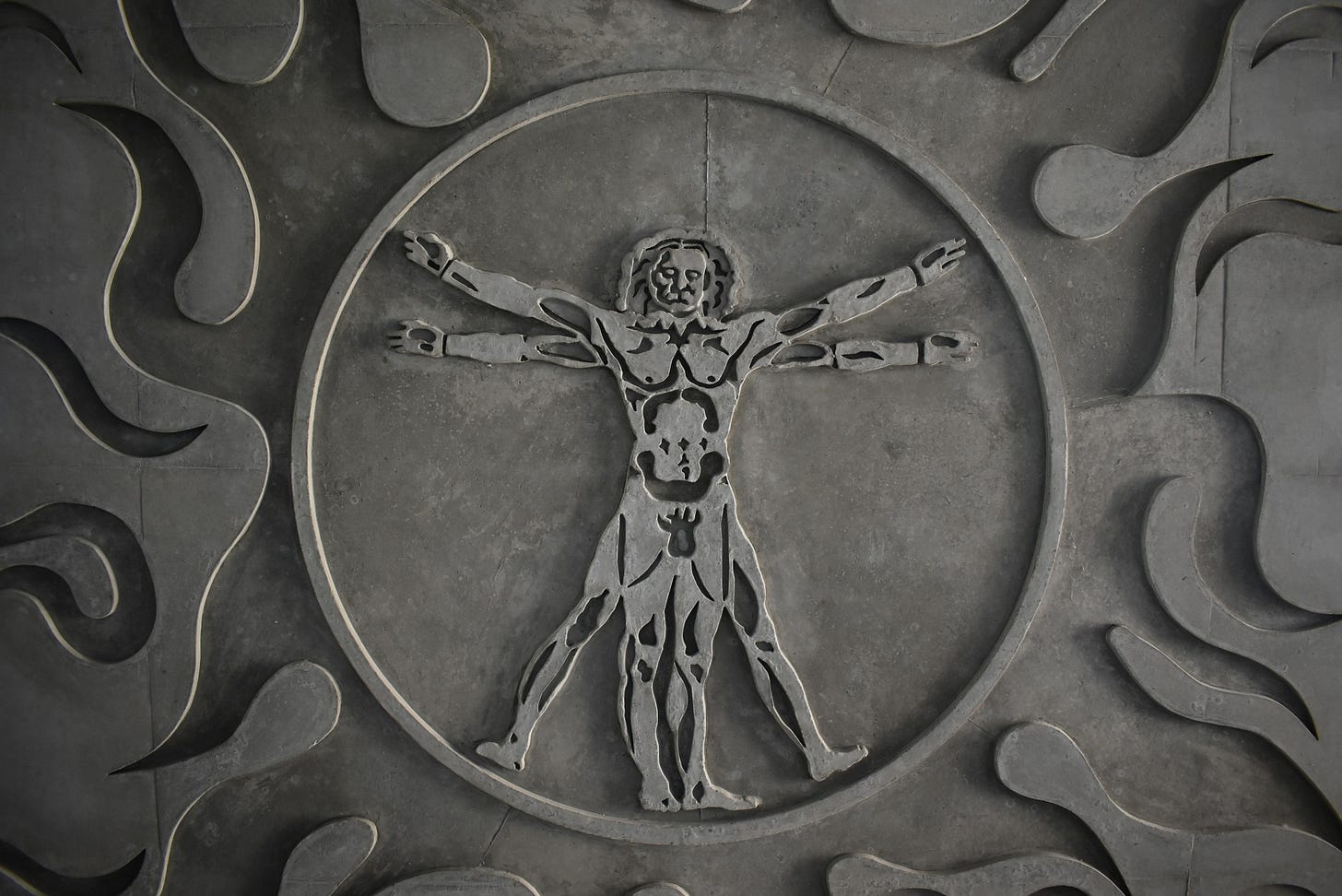We live in a time of crisis:
an opioid crisis
a climate crisis
an economic crisis
a mental health crisis
political crises in many countries
multiple geopolitical crises around the globe
…and more. It often feels like our societies, if not our entire culture, are about to collapse. And maybe it really is.
Here’s my thesis, which I want to explain in this essay (and I invite you to criticize it):
The core reason for this meta-crisis is the way we view ourselves as humans—our model of what humans are. And if we want to have any chance of solving the meta-crisis, we must change how we view ourselves.
Here’s my argument in short form. I’ll elaborate on each point below.
Your model of the human being determines what you expect humans to be and do.
The dominant model of the human being is the machine.
Because humans see themselves as machines, the systems they build around themselves (the education system, the world of work, the economic system, the healthcare system and so on) are built for machines, and are themselves bigger machines.
Because the machine is an inadequate model for humans, these systems aren’t sustainable, which is why they are in crisis.
To evolve these systems into something sustainable, we first need to evolve our model of what humans are.
Let’s look at this argument in detail.

1. Your model of humans determines what you expect humans to be and do
Here’s why your model of humans matters:
You only see what you expect to see.
What you expect to see depends on your model of the world (or of humans).
Therefore, your model determines what you see—and more importantly, what you don’t see.
Another way to say this is that your model of humans is the sum of your expectations about humans—about how they behave, what their needs and motivations are, and so on.
Now, what’s the dominant model of humans in Western culture?
It’s the machine.
This is reflected in our speech patterns. We’re “functioning on autopilot” until we “burn out” and need to “recharge.” We say that people are “hard-wired” to behave a certain way. And I could go on.
Many of our intellectual and public figures also express the view that a machine is the most fitting model for humans.
For example, evolutionary biologist Richard Dawkins says:
"We are survival machines—robot vehicles blindly programmed to preserve the selfish molecules known as genes."
Similarly, in his book Homo Deus, Noah Yuval Harari says:
“Homo Sapiens is an obsolete algorithm.”
He goes on to wonder what the “advantage” of humans over chickens is and concludes it’s “only that in humans information flows in much more complex patterns. Humans absorb more data, and process it using better algorithms than do chickens.”
And industrial thinker and engineer Frederick Taylor (to whom we owe the idea of division of work) says:
"In the past, the man has been first; in the future, the system must be first"
Thus implying that man himself is part of a larger machine that’s more important than him.
Medicine and science as a whole views humans as machines, which is why they were so obsessed with the sick human rather than the normally functioning human for the longest time. A machine only deserves attention when it’s not working as it should.
The machine is the model that guides thinking about humans in our culture.
2. The dominant model of humans is the machine, and the most important thing about machines is their function
If you’re using the machine as your model of humans, that means you apply the characteristics of machines to humans. And the most important characteristic of machines is that they have a function. They are built to do something—usually something very specific. That’s their only purpose. They are supposed to do that, and nothing else. Everything apart from that function is secondary.
If you look back in history to the Industrial Age, it’s obvious that this is precisely how humans were seen, beginning in this age.
Of course, we have moved away from the extremes of Taylorism, and the machine we use as the model keeps changing. For example, the brain was thought of as a computer for the long time, and humans merely as computers on legs. But the basic idea that humans are machines is still intact.
Think about how much people’s sense of self-worth depends on their work (their “function”). Look at how people who don’t work—or even worse, who don’t want to work—are shamed. If you don’t want to fulfill a clear function in the machine of society, you are worthless.

3. Machines create bigger machines
It doesn’t stop with the individual person, though. When you look at humans as machines, you build systems around them that are made for machines.
Think of the education system. The way we teach kids in school prepares them, not to be self-determined free agents in the world, but cogs in a machine.
Think of the health care system. It’s all about restoring a person’s work ability—their ability to fulfill their function. And since humans are viewed as machines, that means replacing parts that aren’t working anymore, inserting chemicals that are missing, and so on.
And, most of all, think of the economy and of our work life. For many people, all of their time is spent fulfilling a function, preparing to fulfill that function in the morning, and resting from fulfilling that function in the evenings and on weekends, just so they can do it all over again come Monday. Companies talk about people as “human resources” and about nature as “natural resources”—everything is seen as raw material for the machine.
We are machines building larger machines of which we are parts.
4. The machine isn’t working anymore
But after almost 300 years of thinking of humans as machines and of re-building our societies into a giant machine, it’s becoming clearer and clearer that this model is deeply flawed.
The meta-crisis I mentioned above is one effect of this. The entire system is in crisis because the entire system is built on a flawed premise.
If we don’t want our societies and our culture to collapse, we need to transform the machine into something else—something less flawed.
But we shouldn’t do that by force. Industrialization—the transformation that got us here in the first place—was a transformation by force (as was Soviet communism, by the way). These kinds of radical transformations come with high costs and are never sustainable.
What we need is an evolution of the system. And that evolution starts with a better model for what humans are.
5. A better model
What would be a better, more adequate model for humans? To find an answer to this question, it’s useful to look back in time.
Because it wasn’t always the case that we viewed humans as machines. For example, during the Renaissance, a very different model dominated: Humans were seen as a reflection of the cosmos—a microcosm within the macrocosm. Like a hologram, every human is seen as a complete image of the cosmos, just on a smaller scale.
And like the cosmos, humans were seen as creative, self-directed agents who embody harmony and balance, and who are in constant flow.
Mind, body and soul were seen as interconnected, human potential as expansive, just like the cosmos. All that is reflected in that ultimate prototype of the Renaissance man—Leonardo da Vinci.
I believe this model is much more aligned with what humans are, and with what life itself is about.
Sure, a microcosm within a macrocosm isn’t really a precise model. But the machine isn’t a precise model either because there are all kinds of different machines, and they keep evolving.
And on top of this, life just cannot be pressed into a rigid model. If you try it, life loses its resonance. Any model that we use has to be open if it is to serve human life, rather than have human life serve the model.
Here’s another model I like:
You are a unique piece of music, composed by the Universe (or God, if you prefer—those words mean the same thing to me). And like music, you don’t have a “function”. Like music, the only function of you is you.
You don’t have a “function” and you don’t need to justify your existence by being “useful”. There is no existential debt you have to repay. You are enough, just as you are.

6. How to start a (R)Evolution
The question remains: How do you begin the evolution of our culture and society?
You do it one person at a time.
The model I like to use when I think about transformation is the caterpillar that is transformed into a butterfly. Have you ever wondered how that process happens? I have, and here’ what I found out:
Once the caterpillar is in its cocoon, enzymes are released, which gradually dissolve the cell structure of the caterpillar. The caterpillar tissue is dissolved into special proteins that reorganize into new cells.
These new cells—the so-called imago cells—are different enough from the caterpillar cells so as not to be dissolved to the same degree as the caterpillar cells. But they are also not yet butterfly cells, which is why some of them are destroyed.
But over time, the imago cells become too many for them to be destroyed—and that’s when they take over. After that, it’s the imago cells that direct the transformation process, and by working together, they eventually build that beautiful butterfly.
“Fascinating,” as Mr. Spock would say, isn’t it?
You can be one of these imago cells for the system that is our culture and society. It’s what I consider myself to be. I believe we need a New Renaissance. Hence the name of this Substack.
And that New Renaissance starts with you.
With a single human being, a single imago cell that stops seeing itself as a machine. Because the individual human being is at the heart of all the systems and sub-systems of culture and society.
The more people adopt a more adequate model for what humans are, the more the effects of this small change will ripple through all the systems that surround us, and eventually transform them.
I don’t know what these new systems will look like. But because they will all flow from a model of humans that is more aligned with life itself, I’m sure they will serve us much better than what we have now.
Other ways I can help you: If you need help building a more meaningful life, I offer 1:1 coaching. I work with multipotentialites, artists, and basically all adventurers of life who want to create their own path through life. If you’re interested, I invite you to book a free 30-minute discovery call.

